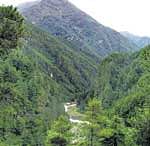
The Sagarmatha National Park, Nepal, referred to as the ‘Park on the roof of the world’ has been designed to protect the Himalayan mountains, the flora and fauna there and the lifestyle of the Sherpas. It has some of the tallest 8000 m peaks like Mt Everest (Sagarmatha), Lhotse and Lhotse Shar. Recognising the importance of preserving these for posterity, the Park was created in 1976, with its headquarters at Namche Bazar.
UNESCO listed the park, which attracts a number of trekkers and mountaineers throughout the year, as a World Heritage Site in 1979 .
The Park encompasses an area of 1,148 sq. km with rugged terrain, high mountains, glaciers, gorges and lakes. Two rivers take off from there, Dudhkoshi and Bhotekoshi. Some efforts have been made like greening the Namche hill which was at one point thickly forested. In the lower altitudes, pine, fir, juniper, birch and rhododendron are found. The upper region is a cold desert except for some scrub and alpine type vegetation.
Rich in biodiversity
Regions like the Pheriche Valley are the windiest and coldest in the world. There are about 28 species of mammals, including the red panda, snow leopard, musk deer, and Himalayan tahr. Colourful birds like Impeyan pheasant and butterflies are found at lower heights.
What’s interesting about the park is that it is a vehicle-free zone. Yaks, horses and human beings carry goods from place to place. It is recommended that guests have meals together at a fixed time so that the kitchen and the fuel, could be used economically. The region is rich in hydropower and that’s why a number of micro hydroelectric stations have come up that light up the villages and provide energy for lighting and heating. Use of firewood has been banned to prevent chopping of trees. Kerosene, LPG and solar energy are used.
Though trekking related activity is the mainstay of the Sherpas, they grow vegetables, apples, potatoes, and corn, raise yaks and poultry to sustain their livelihood. Hordes of trekkers and mountaineers leave their eco-print on the fragile Himalayan altitudes. The Sagarmatha Pollution Control Committee (SPCC) has made efforts to promote a clean environment and to see that waste is deposited in designated ‘green’ bins located along the trail. Instead of glass bottles, metal cans are encouraged, as these are easier to crush, transport and recycle. Most people in the region use CFL lamps instead of incandescent lamps. Initiatives like ‘Clean up Island Peak’ and ‘Everest Marathon’ have been designed to create awareness about the need to conserve the Park. The modest entrance fee is utilised towards conservation measures such as strengthening infrastructure like trails and hanging bridges.
There is hope that trekkers become more eco-friendly. However, there is a clear sign that more lodges are coming up all along the trail. This does not bode well for the environment. While a moratorium on the number of trekkers is difficult to enforce as the Sherpa economy is closely linked to tourism, we can hope more measures are taken to conserve the Himalayan environment.